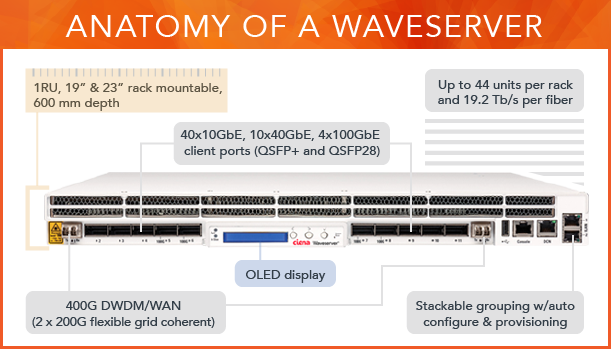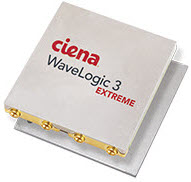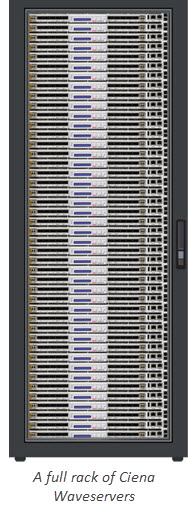Ciena’s new Waveserver: a dream machine for data center interconnect
Ciena has today introduced the Waveserver™, a compact and purpose-built platform capable of enabling massive multi-terabit bandwidth for metro data center interconnect (DCI). At only one rack unit (1RU) in size, this stackable interconnect system is packed with hardware and software features that enable simple deployment and provisioning for today’s web-scale data center environments.
Its combination of power and density provides 60% more capacity per rack unit and nearly twice the fiber capacity (20 terabits per fiber) versus competing available platforms.

Killer specs
Waveserver’s massive line-side capacity is rooted in its use of Ciena’s new state-of-the-art WaveLogic 3 Extreme coherent optical chipset, which enables the use of 200G wavelengths and flexible grid. With 800G of total capacity per box, Waveserver delivers bandwidth and programmability like no other DCI platform can.
 “In a pizza box format, it can do 400 gigabits on the line side, 400 gigabits in terms of clients, up to 20 terabits on a fiber – more capacity than anybody, more density than anybody,” said Rick Dodd, SVP of Portfolio Marketing at Ciena.
“In a pizza box format, it can do 400 gigabits on the line side, 400 gigabits in terms of clients, up to 20 terabits on a fiber – more capacity than anybody, more density than anybody,” said Rick Dodd, SVP of Portfolio Marketing at Ciena.
The svelte styling of the 1RU unit highlights the single-purpose nature of Waveserver: Ethernet-based data center interconnect at local and metro distances.
The result is a platform that achieves significantly lower cost per transported bit and lower cost per bit per rack versus available competing products.
For more Waveserver specs download the Waveserver data sheet.
An ICP’s/CNPs dream machine
Waveserver is at home within the web-scale dynamic of a data center. Built for easy ordering, fast installation, and server-like management, Ciena has designed Waveserver to the scalable and modular priorities that Internet Content Providers (ICPs), Carrier Neutral Providers (CNPs) and other data center operators demand.
Stripped down to the essential requirements of data center interconnect, Waveserver only supports Ethernet transport. 10 client ports support plug-and-play 100GbE / 400GbE / 10GbE via a mix of QSFP+ and QSFP28 ports, while two line-side optical ports support 200G each at distances up to 150 km via Ciena’s next gen 16QAM coherent modulation format.

Server-like management and Open APIs
But Waveserver is more than just a hardware story. The rich software  features and open APIs built into Ciena’s Waveserver platform are what truly make Waveserver a platform built for the web-scale age.
features and open APIs built into Ciena’s Waveserver platform are what truly make Waveserver a platform built for the web-scale age.
“Waveserver implements new interfaces that allow operators to talk directly to the platform in a much simpler way,” said Dave Miedema, one of the lead photonic software architects for Waveserver development. “We came up with the idea to manage these boxes in a cluster and use the way they’re connected from a comms perspective to automatically associate them as a group.”
That means racks of Waveservers can be clustered, provisioned and managed as a group. Waveserver’s Essentials app further simplifies management. Waveserver Essentials is an all-in-one platform-independent app (smartphone/tablet, desktop, web, etc.) for planning, ordering, installing, provisioning and managing Waveserver deployments.
In addition, an LED display on the front panel can provide everything from alarms to port usage data to scannable login QR codes. You can literally turn up 400G of capacity in minutes while only using the push buttons and the LED screen on the faceplate.
A set of REST APIs provide open and programmable interfaces, allowing ICPs/CNPs and data center operators to easily connect and automate Waveserver functions with back-office scripts, other related technology, and software tools.

A deep dive on Waveserver
Some of the R&D engineers that helped lead the development of Waveserver host a live Google Hangout broadcast today at 12:00pm ET (5:00pm GMT), where they will discuss the features, specs and operations of the new platform. Join the discussion and ask questions via Twitter using the #CienaLive hashtag.
In addition, download the Waveserver data sheet and the Waveserver white paper for more details, flip through our Waveserver pictures on Facebook, and watch our entire playlist of Waveserver videos, the first of which is embedded below.




